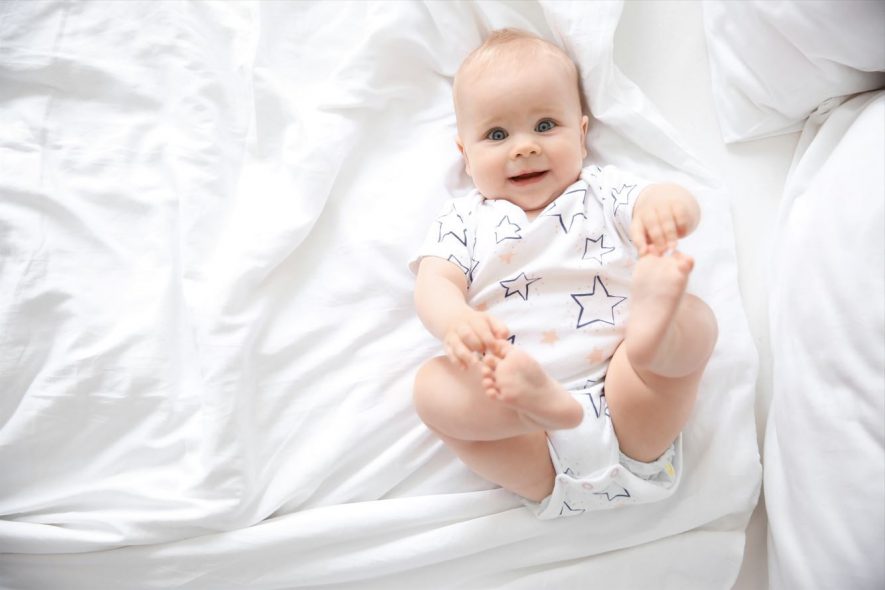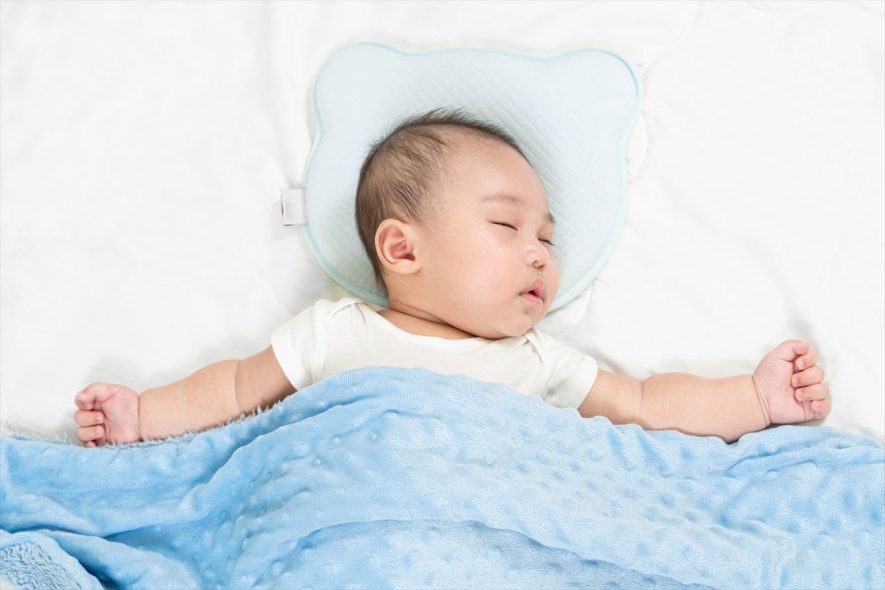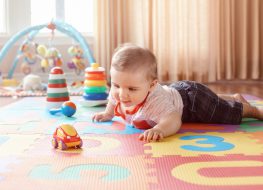
A baby’s head is particularly susceptible to changes caused by external factors. Sleep and sleeping environment play a dominant factor in how it shapes. Thus, keeping your baby’s head healthy involves your participation.
This article will explore the characteristics of your baby’s head, how both sleep and sleeping environment play a role in its development, and how baby pillows can promote healthy heads.
Things You Need to Know About Your Baby’s Head
Nature seems to be giving babies’ heads certain characteristics that communicate something important—that they should be prioritized for proper development. Here are the characteristics you have to keep in mind:
Babies heads are large
During the first few months, babies have disproportionately large heads, and it makes up roughly 25% of their whole body. This takes considerable weight on the babies’ upper body area, demanding its proportionate share of care.
Skulls are soft
The bones that makeup babies’ skulls start relatively soft and fragile. Nature has made it this way so that babies can move through the birth canal as smoothly as possible. On the other hand, the soft bones of the skull during the first few months can still be malleable. This characteristic of the skull gives room for babies to develop one of the most important parts of the baby’s body—the brain.
The Fontanelles
If you’ve ever touched the top portion of your baby’s skull and felt something soft, don’t be alarmed. These soft spots are called fontanelles—sections of your baby’s skull where bones haven’t grown yet. To put simply, fontanelles act as a buffer for your baby’s skull where a quickly developing brain expands. These skull gaps slowly fuse over a span of 2 to 18 months.
These characteristics make babies’ heads susceptible to changes, especially the ones influenced by external factors. That’s why in order for us to provide the proper care for our babies and the health of their heads, we have to examine the prevailing external factors that heavily affect change.
One major factor to consider is sleep.

The Role of Sleep in Shaping Your Baby’s Head
For a baby, sleep plays a major part in their development. This downtime is when the body takes its opportunity to grow. So, it completely makes sense that babies tend to get as much of it as they can. It’s nature’s way of helping them progress towards a functional human being in a relatively short span of time.
Exploring the role of sleep in our baby’s lives allows us to examine and understand what tangible things can affect our baby’s growth and development—particularly in the head area.
Average Sleep Duration
The average sleeping duration of babies varies depending on how old they are. But one thing is certain; it should be more than what adults get daily. Here’s the breakdown:
Newborns – Babies from 0 to 3 months old are notorious sleepyheads. Their average sleeping duration is between 14 to 17 hours.
Older babies – There’s only a small change in sleep duration for infants aged 4 to 12 months old. 12 to 16 hours of sleep would suffice.
It’s important to note that the sleep duration isn’t a long stretch of uninterrupted downtime but a staggered one. And the longest sleep duration for babies often happens during nighttime because of their circadian rhythm.
Sleep Environment
Baby’s lengthy sleep time prompts us to consider another sleep-related factor—the environment they sleep in. It can influence their behavior, movement, and physical growth. Here are some things you can consider to ensure your baby gets the best sleep they can get:
Temperature – Is it too hot, too cold, or is the room temperature just right for your baby to sleep soundly?
Sound – Consider the sounds surrounding your baby’s sleep environment. Ideally, the environment should be quiet, and at the very least, the sounds should at least be soothing to avoid any disturbance.
Objects – Consider where your baby sleeps. Is the crib pleasant to the baby’s eyes, comfortable, and ergonomic for parents? Does your baby have a pillow that keeps him cozy and intact?
As a parent who only wants the best for your baby, you need to consider these factors with one thing in mind: to ensure your baby is sleeping soundly with minimal disturbance.
You also want to ensure that your babies don’t change positions when they sleep because a change in position increases their risk of Sudden Infant Death Syndrome (SIDS).
If you have been learning parenting skills, you would know that your baby should be kept lying on their backs while sleeping. This is the optimum position that minimizes all the risks and maximizes development. But while sleeping on his back has a lot of benefits, it does have its dark side that you need to always keep in mind.
The Dark Side of Babies Sleeping on Their Backs
We know that babies should be kept lying on their backs to minimize the risks. But what many parents don’t know is there are negative effects when keeping our babies in this position for prolonged periods.
This effect is commonly known as flat head syndrome, otherwise known as Positional Plagiocephaly (PP).
What is Flat Head Syndrome?
Flat head syndrome is a condition that causes the baby’s skull to slightly deform on one or both sides. This usually happens when a baby spends a lot of time sleeping on his back without much room for movement.
Several compounded factors cause the flat head syndrome. The baby’s soft skull is the primary factor, add to it a sleeping environment that lacks head and neck support for your baby, and you get the right conditions for PP.
What are the consequences of Flat Head Syndrome?
For most parents, flat head syndrome is best left on its own because of the impression that the head will eventually mold itself into the right shape as the baby grows up. But what parents must know is that there are consequences associated with flat head syndrome in both the short and long run—and they have to act on it now.
Delays in development
The developmental delays resulting from a flat head syndrome are seen in the baby’s motor development, language, and cognition. If a baby has a flat head, he may have difficulty developing skills such as walking, holding objects, absorbing, and speaking a language.
Adult psychological well-being
If left untreated, a flat head syndrome during the critical first year of a baby may have permanent effects. It can carry over to adulthood. And a severe flat head can affect an adult’s psychological well-being.
What are the best ways to prevent Flat Head Syndrome?
One of the ways flat head syndrome can be prevented is by letting your baby sleep on his tummy under close supervision. Have your baby spend a fraction of his sleeping time lying prone on your stomach. This way, he keeps developing and growing a stronger neck.
Parents have to be concerned with the consequences of flat head syndrome. And the best time to prevent or treat this condition while you put your baby to sleep on his back is by using a baby head shaping pillow safe and intact under your child’s head.

Forming a Healthy Head Shape With the Help of a Pillow
A baby head shaping pillow is an ergonomic-shaped cushion that provides soft support for your baby’s neck, back, and hips while he sleeps on his back.
Ashtonbee’s baby head shaping pillow delivers the same effect. This newborn baby pillow not only supports your baby it also delivers the right conditions for your baby to sleep soundly. Here are some of the features that make Ashtonbee baby pillows the best baby head shaping pillow you can get.
- Neck airflow to prevent sweating and aid in comfort
- Design and technology helps head and spine alignment
- Hypoallergenic
- Memory foam that supports your baby’s comfortable head position
- Recommended by pediatricians for flat head syndrome
Heading Towards Healthy and Unhampered Development
The most important development of a baby starts and ends at the top. The brain is where everything is processed and controlled. That’s why as parents, you can’t afford to be complicit when it comes to matters involving the health of your baby. So it’s only right that you give it the right shape that is conducive for unhampered development.



